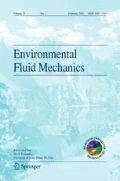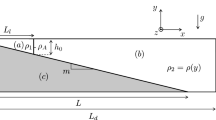Abstract
During floods, the density of river water usually increases due to a subsequent increase in the concentration of the suspended sediment that the river carries, causing the river to plunge underneath the free surface of a receiving water basin and form a turbidity current that continues to flow along the bottom. The study and understanding of such complex phenomena is of great importance, as they constitute one of the major mechanisms for suspended sediment transport from rivers into oceans, lakes or reservoirs. Unlike most of the previous numerical investigations on turbidity currents, in this paper, a 3D numerical model that simulates the dynamics and flow structure of turbidity currents, through a multiphase flow approach is proposed, using the commercial CFD code FLUENT. A series of numerical simulations that reproduce particular published laboratory flows are presented. The detailed qualitative and quantitative comparison of numerical with laboratory results indicates that apart from the global flow structure, the proposed numerical approach efficiently predicts various important aspects of turbidity current flows, such as the effect of suspended sediment mixture composition in the temporal and spatial evolution of the simulated currents, the interaction of turbidity currents with loose sediment bottom layers and the formation of internal hydraulic jumps. Furthermore, various extreme cases among the numerical runs considered are further analyzed, in order to identify the importance of various controlling flow parameters.
Similar content being viewed by others
References
Mulder T, Alexander J (2001) The physical character of subaqueous sedimentary density flows and their deposits. Sedimentology 48: 269–299
Janbu NE, Nemec W, Kırman E, Özaksoy V (2009) Facies anatomy of a channelized sandrich turbiditic system: the Eocene Kusuri Formation in the Sinop Basin, north-central Turkey. In: Nichols G, Paola C, Williams E, Paola C (eds) Sedimentary processes, environments and basins. Wiley, Special Publication Number 38 of the International Association of Sedimentologists, Kingston upon Thames, UK, pp 457–517
Posamentier HW, Kolla V (2003) Seismic geomorphology and stratigraphy of depositional elements in deep-water settings. J Sediment Res 73(3): 367–388
Saller A, Werner K, Sugiaman F, Cebastiant A, May R, Glenn D, Barker C (2008) Characteristics of Pleistocene deep-water fan lobes and their application to an upper Miocene reservoir model, offshore East Kalimantan, Indonesia. AAPG Bull 92(7): 919–949
Lovell JPB (1971) Control of slope on deposition from small-scale turbidity currents : experimental results and possible geological significance. Sedimentology 17: 81–88
Simpson JE, Britter RE (1979) The dynamics of the head of a gravity current advancing over a horizontal surface. J Fluid Mech 94: 477–495
Britter RE, Linden PF (1980) The motion of the front of a gravity current travelling down an incline. J Fluid Mech 99: 531–543
Garcia M, Parker G (1989) Experiments on hydraulic jumps in turbidity currents near a canyon-fan transition. Science. doi:10.1126/science.245.4916.393
Kneller BC, Bennett SJ, McCaffrey WD (1997) Velocity and turbulence structure of density currents and internal solitary waves: potential sediment transport and the formation of wave ripples in deep water. Sediment Geol 112: 235–250
Gladstone C, Phillips JC, Sparks RSJ (1998) Experiments on bidisperse, constant-volume gravity currents: propagation and sediment deposition. Sedimentology 45: 833–843
Baas JH, Van Kesteren W, Postma G (2004) Deposits of depletive, quasi-steady high density turbidity currents: a flume analogue of bed geometry, structure and texture. Sedimentology 51: 1053–1089
Garcia M (1994) Depositional turbidity currents laden with poorly sorted sediment. J Hydraul Eng 120(11): 1240–1263
Hartel C, Meiburg E, Necker F (2000) Analysis and direct numerical simulation of the flow at a gravity-current head: Part 1. Flow topology and front speed for slip and no-slip boundaries. J Fluid Mech 418: 189–212
Kassem A, Imran J (2001) Simulation of turbid underflows generated by the plunging of a river. Geology 29(7): 655–658
Heimsund S, Hansen EWM, Nemec W (2002) Computational 3D fluid-dynamics model for sediment transport, erosion and deposition by turbidity currents. In: Knoper M, Cairncross B (eds) Abstracts, international association of sedimentologists 16th international sedimentological congress. Rand Afrikaans University, Johannesburg, pp 151–152
Lavelli A, Boillat JL, De Cesare G (2002) Numerical 3D modelling of the vertical mass exchange induced by turbidity currents in Lake Lugano (Switzerland). In: Proceedings 5th international conference on hydro-science and -engineering (ICHE-2002) (Reference: LCH-CONF-2002-012 Note: [355])
Necker F, Hartel C, Kleiser L, Meinburg E (2002) High-resolution simulations of particle driven gravity currents. Int J Multiph Flow 28: 279–300
Cantero M, Garcia M, Buscaglia G, Bombardelli F, Dari E (2003) Multidimensional CFD simulation of a discontinuous density current. In: Proceedings of the XXX IAHR international congress, Thessaloniki, Greece, 2003
Bombardelli FA, Cantero MI, Buscaglia GC, García MH (2004) Comparative study of convergence of CFD comercial codes when simulating dense underflows. In: Buscaglia G, Dari E, Zamonsky O (eds) Mec’anica Computacional, vol XXIII. Bariloche, Argentina, November 2004
Imran J, Kassem A, Khan SM (2004) Three-dimensional modeling of density current. I. Flow in straight confined and unconfined channels. J Hydraul Res 42(6): 578–590
Blanchette F, Strauss M, Meiburg E, Kneller B, Glinsky ME (2005) High-resolution numerical simulations of resuspending gravity currents: conditions for self-sustainment. J Geophys Res 110: C12022. doi:10.1029/2005JC002927
Huang H, Imran J, Pirmez C (2005) Numerical model of turbidity currents with a deforming bottom boundary. J Hydraul Eng 131(4): 283–293
Ooi SK, Constantinescu G, Weber LJ (2007) 2D large-eddy simulation of lock-exchange gravity current flows at high Grashof numbers. J Hydraul Eng 133(9): 1037–1047
Mehdizadeh A, Firoozabadi B, Farhanieh B (2008) Numerical simulation of turbidity current using \({\overline{v^{2}}-f}\) turbulence model. J Appl Fluid Mech 1(2): 45–55
Cantero MI, Balachandar S, Garcia MH (2008) An Eulerian–Eulerian model for gravity currents driven by inertial paricles. Int J Multiph Flow 34: 484–501
Cantero MI, Balachandar S, Garcia MH, Bock D (2008) Turbulent structures in planar gravity currents and their influence on the flow dynamics. J Geophys Res 113: C08018. doi:10.1029/2007JC004645
Singh J (2008) Simulation of suspension gravity currents with different initial aspect ratio and layout of turbidity fence. Appl Math Model 32: 2329–2346
ANSYS FLUENT 6.3.26 User’s Guide (2008)
Hinze JO (1975) Turbulence. Mc Graw-Hill Publishing Co, New York
Bombardelli FA, Jha SK (2009) Hierarchical modeling of the dilute transport of suspended sediment in open channels. Environ Fluid Mech 9: 207–235
Dey S (1999) Sediment threshold. Appl Math Model 23: 399–417
Farrell GJ, Stefan HG (1986) Buoyancy induced plunging flows into reservoirs and coastal regions. Tech. Rep. No. 241, At. Anthony Falls Hydr. Lab., University of Minnesota, MN
Cebeci T, Bradshaw P (1977) Momentum transfer in boundary layers. Hemisphere Publishing Corporation, New York
Author information
Authors and Affiliations
Corresponding author
Rights and permissions
About this article
Cite this article
Georgoulas, A.N., Angelidis, P.B., Panagiotidis, T.G. et al. 3D numerical modelling of turbidity currents. Environ Fluid Mech 10, 603–635 (2010). https://doi.org/10.1007/s10652-010-9182-z
Received:
Accepted:
Published:
Issue Date:
DOI: https://doi.org/10.1007/s10652-010-9182-z




